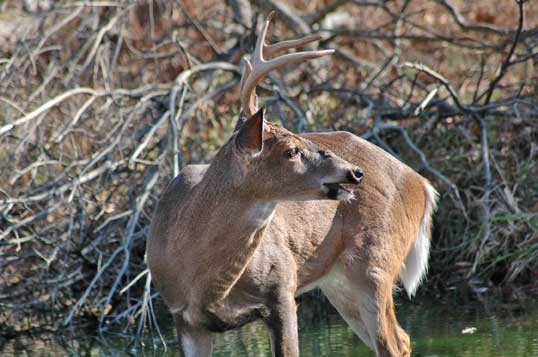Alan Benton | Mossy Oak ProStaff

Deer become accustomed to the sights, smells and sounds around them. For instance, if an older-age-class deer sets up a residency close to three or four houses, I think he can distinguish the difference between the way the people who live in that neighborhood smell from a hunter who comes into the woods and has an odor different from the neighborhood folks.
If dogs are behind a fence, the deer understands that those dogs won’t bother him. If there’s loud music, the deer become conditioned to those sounds. If a farmer is plowing on a tractor, the deer know those sounds and smells don’t threaten him. But if you pull up in a four wheeler near where that deer is bedding or feeding, the deer quickly will move away from you.
I’ve learned when I’m hunting small properties to only hunt them with a favorable wind. I’ll walk to my stand site, rather than taking my vehicle there. Recognizing these elements are major factors in your deer-hunting success, if you hunt near urban areas.
Another somewhat odd tactic is to ask the landowner if you can borrow some of his dirty clothes to wear hunting. Then if the buck does smell you, he’ll be smelling a familiar smell that’s never posed a danger to him. I came up with this theory from watching ranchers who used their trucks to drive around pastures to check their cattle. Some of these ranchers would see deer bedding right on the side of the road. Once the truck approached and even after it passed, those bucks didn’t break out of their beds and run. They’d been conditioned to the sound of the truck and the rancher’s odor and knew those sounds and smells didn’t pose threats to them. If I drive the same route that the rancher has driven, my truck has a different sound and odor, and my human odor is different. The buck will leave where he’s bedding beside the road and move further into the woods on the edges of the fields.
If you're looking for permission to hunt small tracts of land that are close to residential areas, it may work to your benefit to strictly bow hunt even if it's rifle season.
Forty-one-year-old Alan Benton of McDonough, Georgia, is a 9-year veteran of the Mossy Oak ProStaff.
“Mossy Oak is more than a camo pattern. Mossy Oak is a lifestyle with which I associate,” said Benton. “I like what Mossy Oak represents. Toxey Haas, the creator of Mossy Oak, and his family are hometown people. I like the conservation organizations that Mossy Oak is a part of and supports and the charitable contributions the company makes to help people and wildlife. I feel if I’m going to put my time, effort and money into hunting, I need to be wearing the best camouflage on the market, and I believe Mossy Oak is that camouflage.”



























